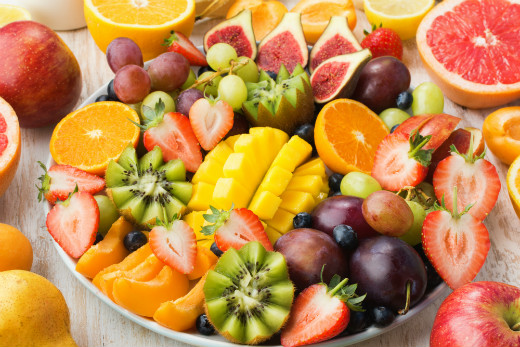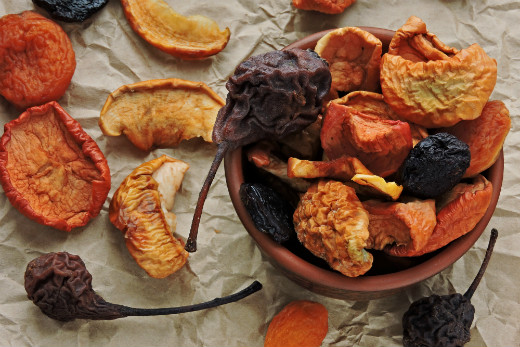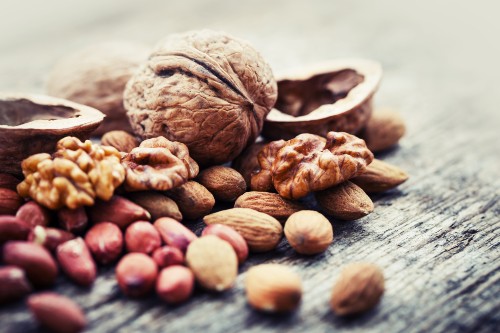By Elisheva Blumberg, Lubicom Staff
Nothing brightens up a gray winter than the prospect of spring… and lucky for us, Tu Bishvat, The New Year for the Trees, is here to remind us of sunnier days to come.
Even if we’re not in the Holy Land watching the almond trees blossom, we can still celebrate Tu Bishvat by taking part in the abundance of G-d’s creation: bring on those cheerful fruit platters!
Here’s the nutritional lowdown on the most common fruits + nuts you’ll encounter on this ecological holiday.

Fresh Fruit
One thing we know for sure: fruit is nature’s candy.
Loading up on fresh fruits provides essential minerals, vitamins, antioxidants, phytochemicals, dietary fiber, and more than likely, a whole host of other good-for-you stuff that science has yet to discover.
Eating more than five servings of fruits and veggies per day, studies have found, reduces the risk of heart disease, stroke, cancer, and more.
When choosing which types of fresh fruit to consume, make sure to “eat the rainbow”; the bright, gorgeous colors in produce are caused by varying phytonutrients — each color boasting its own benefits.

Dried Fruit
Don’t you love that burst of sweet chewiness that comes from dried fruit?
Pears, peaches, apricots, kiwi, papaya, apples, dates, cranberries, bananas, cherries — virtually any fruit can be dried, and when it is, it can taste even more like candy than its fresh counterpart.
But is dried fruit healthy?
In short, yes — but watch out for added sugars, colors, and preservatives.
In its purest form, dried fruit is simply dehydrated fruit, i.e., fresh fruit with much of the H2O removed. For example, fresh grapes are 80% water while raisins are 15% water.
For the most part, dried fruit maintains virtually the same nutrient and fiber content, but in a very concentrated package.
Taking the grapes vs. raisins example, one cup of grapes contains 15 grams of sugar while 1 cup of raisins contains 98 grams of sugar! This may seem shocking at first, but when you consider the serving size of each, you’ll find raisins and grapes to be comparable (a one-ounce box of raisins contains just 20 grams of sugar — you’d have to eat nearly 6 mini-boxes of raisins to get one cup’s worth!)
As long as you keep to recommended portion sizes, natural dried fruit is comparable to fresh fruit in terms of calorie and nutrient content. If you have trouble keeping to small portion sizes, try drinking water along with your dried fruit — this will essentially put back all the hydration that was removed during the drying process, and make it easier to feel full.
Bear in mind this nutritional comparison is only true with dried fruits that have no added sugar; that Tu Bishvat platter you’re eyeing may contain candied dried fruits with added sugar (like those super-sweet yellow chunks of pineapple that taste like a cavity waiting to happen… )
One more note on dried fruit: many of them contain additives that may be unhealthy.
Some dried fruits, like papaya, can be dyed with artificial colors.
Also, most dried fruits contain sulphur dioxide, a preservative that keeps the dried fruit brightly-colored and fresh. Some people, especially those who suffer from asthma, may experience stomach cramps, skin rashes, or asthma-like symptoms after ingesting sulphur dioxide.
For those who want to avoid sulphur dioxide, artificial colors, and added sugar, look for all-natural versions of dried fruits that are prepared without sulfites. To be 100% sure there are no additives, check the ingredients.

Nuts
Gone are the days when nuts were spurned as an unhealthy, fattening snack food. Yes, these little guys do pack a powerful punch in terms of fat — but they’re high in monounsaturated and polyunsaturated fats — macronutrients we now know to be incredibly good for you.
Nuts also provide fiber, protein, and a delightful range of essential vitamins and minerals like B group vitamins, Vitamin E, calcium, iron, zinc, potassium, magnesium, selenium, manganese, and copper.
In fact, eating nuts has been correlated with increased longevity and lower risk of certain chronic illnesses.
Different nuts contain different nutrients; as with fruit, the more variety you eat the more well-rounded your nutrient intake will be.
You can enjoy nuts as varied as almonds, cashews, pistachios, brazil nuts, pecans, walnuts…they’re all delicious and healthy.
Do be aware that some nuts are prepared with added sugars and artificial colors, like chocolate-covered cashews or those pastel-colored Jordan almonds, but — like everything else — these treats can be enjoyed in moderation.
To say otherwise would be…well, kinda nuts.





